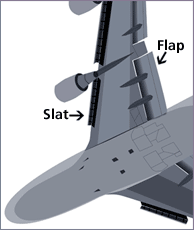

Q. What does the Civil Transport Team do?
We carry out research and development for “people-friendly” passenger aircraft. In order to fulfill that purpose, our R&D activities cover broad areas concerning the aircraft including structure, material, aerodynamics, noise reduction, and the piloting system. In addition, we also promote technological cooperation by sharing our research database, which we have accumulated through our R&D, providing test facilities, and other services.
Q. What does “people-friendly passenger aircraft” mean, precisely?
It means passenger aircraft that are friendly to all people involved, including passengers, neighborhoods surrounding airports, pilots and maintenance engineers. Our goal is to design passenger aircraft that provide safety and comfort to passengers, quiet takeoffs and landings for the neighbors, easy flight operation for pilots, and simple maintenance for the staff. To achieve these goals, five R&D projects are currently underway.
The objective of the first project is to advance aerodynamic design technology for a high-lift device, which will allow aircraft to land and take off on a short runway. Airplanes achieve lift by altering the position of flaps and slats on their main wings, in order to change the airflow around them. JAXA has developed Computational Fluid Dynamics technology that can simulate complicated airflow in order to assist with the design of these flaps and slats. A more efficient lift will enable aircraft to take off and land in a shorter time over a shorter distance, and will also help reduce noise.
The second project is developing technology to reduce aircraft noise. Aircraft noise is produced mainly by the engines, and through the operation of landing gear and high-lift devices during takeoffs and landings. This not only causes noise pollution in airport neighborhoods, but also reduces efficiency, with airports limiting their hours of operation and sometimes imposing penalties on airplanes that are too loud. Thus, through Computational Fluid Dynamics and Computational Aeroacoustics, we are working on understanding the mechanism of aircraft noise and developing new technologies for noise reduction.

* The shapes of flaps and slats depend on the type of aircraft
The third goal is to develop technology to increase passenger cabin safety. We are working on improving impact absorption and seat safety, so that even if an aircraft's structure is damaged in an accident or an emergency landing, the seats stay intact, or at least do not harm the passengers. Our goal is to protect passengers from unexpected events.
The fourth objective is to develop low-cost composite material structure. We are studying new manufacturing technology that will be cheaper than the carbon-fiber-reinforced composites used in aircraft today, and will reduce aircraft weight at the same time. We are targeting a 20-per-cent cost reduction compared to current composite-material structures, and a 20-per-cent weight reduction compared to aluminum structures. Lighter aircraft have higher fuel efficiency, so this will bring economic benefits through energy conservation.
Finally, the fifth project is developing sophisticated pilot systems, with full use of avionics and IT technology. The goal is to improve indicator displays in the cockpits, in order to reduce confusion and pilot error, and to build low-cost pilot systems with sophisticated electric signals.
These are the five pillars of our people-friendly passenger aircraft program.
Q. What is your role on the Civil Transport Team?
I'm engaged in research on low-cost composite material structure. A composite material consists of two or more different materials, and it is lighter and stronger than a singular material.
The composite material we are developing for aircraft is stronger and lighter than conventional aluminum alloy structures, so it will help reduce aircraft weight and fuel consumption. The problem is that composite materials are expensive to produce, so they have generally accounted for no more than 10 per cent of the total weight of a typical passenger aircraft. Now that's changing, as countries around the world become more concerned with protecting the environment and saving energy. The fuselages and main wings of the latest aircraft, such as the Boeing 787 and the Airbus A380, are made of almost 50 per cent composite materials. Naturally, the next step is to reduce manufacturing costs. With a new technology called Vacuum Assisted Resin Transfer Molding (VARTM), we are working on the design and production of a low-cost composite material.
Before this new composite material can be used in passenger aircraft, it has to be granted Type Certification by the Ministry of Land, Infrastructure and Transport. It falls to the Civil Aviation Bureau to test the technology and make sure it meets safety standards. This manufacturing method is so new, though, that there are no standards against which to test the material. So we are also working with the Civil Aviation Bureau to find the best method of certification.
Another development is a device and technique to detect faults inside a composite structure - called Non Destructive Inspection technology. One advantage of composite material is its low weight, but a serious disadvantage is that you cannot see internal damage from the outside. When metal sustains an impact, it's easy to spot the damage - the surface is dented or cracked. But with composite material, even if there is no sign of damage on the surface, there could be a big crack inside. This type of damage has to be detected; otherwise it can trigger a serious accident. Also, the surface of the low-cost composite material we are developing is slightly rougher than that of conventional composites, and for that reason there is the possibility that a special inspection method will be required.
When composite materials become more widely used in aircraft structure, we will have to carry out efficient Non Destructive Inspection on a much wider range of components. Therefore, development of inspection technology is very important.